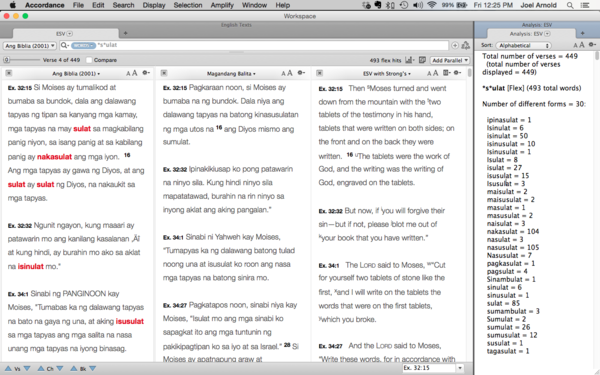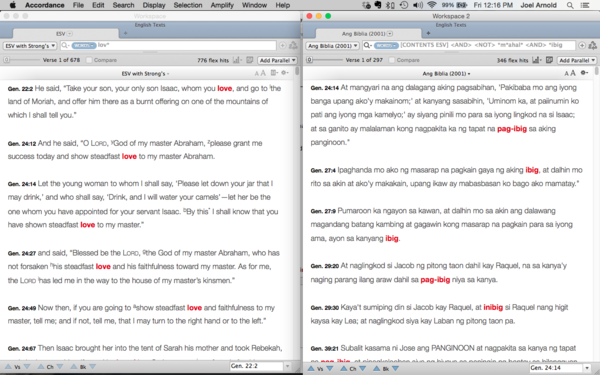Note: Today’s guest post is from Accordance user, Joel Arnold. See more about Joel at the bottom of this blog entry.
A little over 18 months ago my family moved to the Philippines, and for the last year I have been studying Tagalog intensively. There’s lots of money in language learning and all kinds of expensive programs exist to help you on your way. But I realized that I already owned a really powerful tool in Accordance, and using it for language study didn’t have to cost me anything extra. It quickly became my favorite tool.
Here’s why. Multiple quality Tagalog (Filipino) translations exist, and a number are available for free on free Bible software or mobile apps. They’re usable enough, but Accordance’s powerful searching tools add an entirely new dimension to how I interact with the text. So I obtained the text of two different Tagalog translations and imported them as a user Bible. Here are three things I now regularly find myself doing:
(1) Using Accordance as my Dictionary
Everyone agrees that the best way to understand and learn new words is in context. Dictionaries are obviously more concise, but it’s no fun and not very memorable to learn a word from a dictionary.
The Bible, on the other hand, is a large enough document that searching on Accordance generally gives me quite a few examples of how a Tagalog word might be used. By putting Tagalog in parallel with the English I’m also able to scan more quickly through those hits.
This can, of course, go either way. When I encounter a new Tagalog word, I search for it and use the English to find out what it means. Or conversely, when I need to know how to render an English concept, I search for the English word and scan the Tagalog.
Best of all, Accordance is fully mobile. Living in a developing country I don’t always have coverage to use Google translate and there aren’t any high quality dictionary apps I can use offline. Accordance is local and it’s fast. Nearly every Tagalog church service I attend finds me searching for 10 or 20 new words on my iPhone.
(2) Exploring Grammar
Tagalog happens to have an unusually complicated verb system with prefixes, infixes suffixes—sometimes all of them simultaneously. Learning a new verb root isn’t enough—you need some information about how the verb works.
And this is where Accordance shines again. Obviously, a tagged text would be ideal (and understandably doesn’t exist), but there’s still a lot you can do using wildcards. To deal with prefixes, suffixes and infixes (letters inserted in the middle of a word), I use wildcards. Hence, *s*ulat* gives me “nagsusulat,” “isinulat,” and “kinasusulatan”—various declined Tagalog forms. I then use analysis to list every occurring form, and at a simple glance I’m seeing a reasonable representation of how that verb works.
I can always get more complicated about it if I want. Sometimes a specific letter might change in certain forms (think “ran” vs. “run” in English). So I can choose a single character wildcard (“*in?m”) or better specific character choices (“*in?(ou)m*) which will give me two related forms—inumin and uminom.
This can create another problem because that search will also give me sinuman—a completely different word. Whenever I get false positives, I can quickly eliminate them with a minus—“*in?(ou)m*-sinuman,” letting me quickly distill my results to what I’m looking for. Confused yet? Be sure to see David Lang’s helpful series on using Wildcards.
3) Exploring Semantic Ranges
Even without a tagged text it’s quite possible to explore what words generally translate a given idea. I start with an English base (of course, Greek and Hebrew could work just as well) where I search for my idea—let’s do lov* (love, lovely, loved, loves, loving, etc). As I read down the Tagalog pane, I start noticing a lot of passages use the “mahal” word family. So now I use the CONTENTS command to move these hits to another search window, where I’m now using the Tagalog text. I could search for [CONTENTS ESV] <AND> *m*ahal* and use analysis to see a list of words, but I can also keep refining to find other options, so I’ll cut these out with [CONTENTS ESV] <AND> <NOT> *m*ahal* until I start another root. That search reveals an even bigger word group—[CONTENTS ESV] <AND> <NOT> *m*ahal* <AND> *ibig. I can continue on until I’m looking at a small set of exotic or highly paraphrastic translations that may or may not be important for me to learn. Glancing back up at the accumulated list of “<AND> <NOT>” words in my search shows me the range of major words that translate my idea.
[I do have to concede that some texts will be inadvertently eliminated because one of the words I found was used somewhere else in the verse. Still, this gives me a “good enough” idea for my purposes—the major ways a word is rendered.]
Conclusion
There are, of course, lots of other things I can do with Accordance, including some basic syntax exploration using the WITHIN command and FOLLOWED BY. Really the sky’s the limit, and I constantly find myself surprised by how Accordance helps me study my new language.
Remember as well, that you can do this even if Accordance doesn’t yet offer an official text in your language. I simply imported my Tagalog as a user Bible.
And finally, it’s important to acknowledge that this method is most helpful if you already have a basic understanding of your language’s grammar and know where to put the wildcards. The process (especially suggestion #3) can be labor intensive. That being said, that’s part of the point—what could be more fun than studying your language by getting absorbed into the biblical text?
Other Tips:
- As you read Scripture in your new language, highlight vocab words you didn’t immediately know. At the end, searching by highlight lets you generate a quick list of new vocab to work on.
- If you consistently use one search window every time you explore new words, when it’s time to review your search history, there is a record of the words you looked up and need to learn.
- Importing a second translation opens up great possibilities for exploring and comparing further. Using the CONTENTS command or even the COMPARE TEXTS feature between the two can help you further discover fascinating translation differences and options.
Joel Arnold (Ph.D. in Theology, 2011) teaches at a seminary in Quezon City, Philippines and regularly writes at RootedThinking.com.



